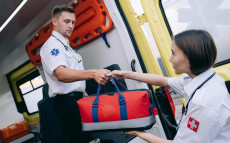- pathfindersAI
- Job Profile
Phlebotomists
Summary
Phlebotomists: A Vital Role in Healthcare
In today’s fast-evolving healthcare landscape, a variety of professionals work collaboratively to ensure patient well-being. Among these crucial roles are Phlebotomists—specialized medical practitioners responsible for the collection of blood samples. Phlebotomists play an indispensable role in diagnosing and treating illnesses, underscoring the significance of their contribution to the healthcare system.
What They Do
Phlebotomists are healthcare professionals trained to draw blood from patients for various laboratory tests, transfusions, donations, or research. Their work is pivotal in obtaining accurate lab results that contribute to diagnosing medical conditions and monitoring treatments. Whether working in hospitals, diagnostic labs, doctor's offices, or blood donation centers, Phlebotomists ensure the collection procedures are safely and efficiently executed.
Job Responsibilities
Phlebotomists carry a diverse range of responsibilities that extend beyond mere blood withdrawal. Firstly, they are tasked with preparing the blood draw equipment and maintaining sterility to prevent infections. Additionally, they identify patients, verify their details, and reassure them to alleviate any anxieties associated with the procedure. Proper labeling of samples, documenting procedures, and ensuring the safety and comfort of patients throughout the process are also paramount responsibilities. Furthermore, Phlebotomists must adhere to stringent protocols and regulatory standards to ensure accurate and reliable test results.
Essential Skills
Becoming a successful Phlebotomist demands a blend of technical competence and interpersonal acumen. Precision and dexterity in handling needles and blood collection tools are paramount to avoid complications and ensure patient comfort. Strong organizational skills are necessary for accurate sample labeling and effective time management. Phlebotomists must also possess excellent communication skills to explain procedures clearly and build rapport with diverse patient populations. Additionally, a high level of patience and empathy can significantly enhance the patient experience, particularly for those who may be anxious or fearful of needles.
Educational Pathways
The pathway to becoming a Phlebotomist typically begins with obtaining a high school diploma or equivalent. Following this, aspiring Phlebotomists need to complete a postsecondary phlebotomy program, which can range from several weeks to several months. These programs, often offered by community colleges or vocational schools, provide comprehensive training in anatomy, medical terminology, and practical phlebotomy techniques. Additionally, obtaining certification from recognized bodies, such as the American Society of Phlebotomy Technicians (ASPT) or the National Healthcareer Association (NHA), can enhance employability and professional credibility. Continuing education and staying updated with the latest advancements in the field are also vital for career progression.
Career Prospects
The demand for Phlebotomists is on a steady rise. According to the U.S. Bureau of Labor Statistics, employment in this field is projected to grow faster than the average for all occupations, driven by an aging population and increased medical testing. Phlebotomists can advance their careers by gaining experience and pursuing additional certifications in specialized areas such as advanced phlebotomy techniques or medical assisting. Opportunities for career growth also exist in supervisory roles, training positions, or transitioning to related healthcare professions.
Conclusion
In conclusion, Phlebotomists hold a critical position within the healthcare hierarchy. Their expertise ensures that blood samples are collected efficiently and safely, enabling accurate diagnoses and effective treatments. With the growing emphasis on medical testing and patient care, the role of Phlebotomists is more crucial than ever. Those who choose this career path can look forward to a rewarding profession, with ample opportunities for growth and advancement. By blending technical skills with compassionate patient care, Phlebotomists truly make a difference in the world of healthcare.
Video
Compensation
| State | Median Salary | Median Hourly | Positions |
|---|---|---|---|
| AL | 36,190 | 17.40 | 2,490 |
| AK | 44,990 | 21.63 | 130 |
| AZ | 41,210 | 19.81 | 4,430 |
| AR | 36,880 | 17.73 | 1,010 |
| CA | 49,120 | 23.62 | 13,010 |
| CO | 45,450 | 21.85 | 2,180 |
| CT | 45,950 | 22.09 | 1,560 |
| DE | 47,980 | 23.07 | 250 |
| DC | * | * | 190 |
| FL | 37,910 | 18.23 | 9,060 |
| GA | 39,920 | 19.19 | 5,920 |
| HI | * | * | 400 |
| ID | 38,740 | 18.63 | 630 |
| IL | 44,530 | 21.41 | 7,830 |
| IN | 37,390 | 17.98 | 2,770 |
| IA | 37,740 | 18.14 | 1,320 |
| KS | 37,870 | 18.21 | 1,010 |
| KY | 37,270 | 17.92 | 2,360 |
| LA | 34,470 | 16.57 | 2,540 |
| ME | 39,400 | 18.94 | 670 |
| MD | 45,990 | 22.11 | 2,630 |
| MA | 47,220 | 22.70 | 2,930 |
| MI | 38,830 | 18.67 | 3,210 |
| MN | 42,090 | 20.24 | 1,360 |
| MS | 32,780 | 15.76 | 1,350 |
| MO | 38,440 | 18.48 | 2,030 |
| MT | 38,150 | 18.34 | 520 |
| NE | 36,360 | 17.48 | 850 |
| NV | 38,250 | 18.39 | 1,020 |
| NH | 45,560 | 21.90 | 650 |
| NJ | 46,770 | 22.49 | 4,290 |
| NM | 38,940 | 18.72 | 710 |
| NY | 48,510 | 23.32 | 6,090 |
| NC | 39,220 | 18.86 | 5,020 |
| ND | 40,100 | 19.28 | 230 |
| OH | 38,110 | 18.32 | 5,290 |
| OK | 35,880 | 17.25 | 1,860 |
| OR | 46,990 | 22.59 | 1,880 |
| PA | 42,790 | 20.57 | 5,330 |
| RI | 45,640 | 21.94 | 710 |
| SC | 37,510 | 18.04 | 2,640 |
| SD | 36,240 | 17.42 | 390 |
| TN | 36,620 | 17.61 | 2,830 |
| TX | 40,880 | 19.66 | 13,080 |
| UT | 36,720 | 17.66 | 1,590 |
| VT | 39,900 | 19.18 | 210 |
| VA | 43,560 | 20.94 | 2,790 |
| WA | 49,130 | 23.62 | 1,710 |
| WV | 36,560 | 17.58 | 1,060 |
| WI | 44,600 | 21.44 | 2,810 |
| WY | 35,810 | 17.22 | 240 |
Similar Occupations
In this area you will find other occupations that are close to the one you were viewing in tasks, knowledge and work environment. If the primary job profile you are viewing isn't quite to your liking, take a look around and see what else is available.
Basic and Premium Accounts have more alternative occupations available than the Free account.

Cardiovascular Technologists and Technicians - 29-2031.00
Cardiovascular Technologists and Technicians are healthcare professionals who assist physicians in diagnosing and treating heart and blood vessel conditions by performing diagnostic tests such as electrocardiograms (EKGs) and vascular ultrasounds. They also monitor patients' heart rates and help during procedures like cardiac catheterizations and angioplasties.
-
$66,170/yr
Median Pay -
55,660
Number of Jobs

Emergency Medical Technicians - 29-2042.00
Emergency Medical Technicians (EMTs) are first responders trained to provide critical pre-hospital care in medical emergencies, ranging from trauma and cardiac incidents to respiratory distress and more. They assess patients, administer necessary medical interventions, and transport patients to healthcare facilities for further treatment.
-
$38,930/yr
Median Pay -
167,040
Number of Jobs